This is a Kodak VR35 K14, a 35mm point and shoot camera manufactured in Japan by Chinon Industries for the Eastman Kodak company between the years 1986 – 1989. It was the top of the line in Kodak’s VR35 family which consisted of at least 15 different models ranging from simple fixed focus cameras, all the way to sophisticated ones like this. The VR35 represented Kodak’s return to producing 35mm cameras after a 17 year hiatus. The VR35 series was released to coincide with a new “VR-G” lineup of Kodak color film, likely to help drive sales. It was a well featured model with a very good 4-element glass lens, advanced auto exposure and auto focus capabilities, a popup flash with fill and night modes, along with a motor drive and a date back.
Film Type: 135 (35mm)
Lens: 35mm f/2.8 Kodak Ektar coated 4-elements
Focus: 3 feet to Infinity Infrared Automatic Focus
Viewfinder: Reverse Galilean Bright Frame with Parallax Marks
Shutter: Programmed Electronic Shutter
Speeds: 1/45 – 1/500 seconds
Exposure Meter: Unknown Type Full Program AE
Battery: 9v Kodak Ultralife Lithium Battery Pack or 9v Alkaline
Battery (Date Back): 3v CR2025
Flash: Pop Up Electronic “Sensalite” Flash with 1.7 second recycle time
Weight: 425 grams (w/ Lithium Battery Pack)
Manual: https://mikeeckman.com/media/KodakVR35K14Manual.pdf
How these ratings work |
The Kodak VR35 series was Kodak’s return to selling Kodak branded 35mm cameras, and although they no longer produced them themselves, the VR35 K12 and K14 were high end models made in Japan by Chinon. Featuring a very good 4-element “Ektar” lens, and a robust feature set including auto focus and automatic exposure, the K14 was Kodak’s top of the line camera upon it’s release. Although comically large by today’s standards, it’s size was on par with similar cameras of it’s era. Despite it’s brick-like shape, the VR35 K14 is capable of excellent photographs and is quite a joy to use. | ||||||
| Images | Handling | Features | Viewfinder | Feel & Beauty | History | Age | |
| 2 | 1 | 2 | 1 | 1 | 1 | 0% | |
| Bonus | +1 for Yashica T-series performance at Kodak prices | ||||||
| Final Score | 9.0 | ||||||
History
The Eastman Kodak Company has had an “on again / off again” relationship with cameras. Since the company’s earliest beginnings, it was a film company first. Yet, for much of the 20th century, millions of cameras were sold emblazoned with a Kodak logo. You could even argue that Kodak film might not have existed had it not been for Kodak cameras. After all, it was the original “Kodak” from 1888 that brought the idea of a reloadable roll film camera to the non professional photographer, and it was the original Brownie box camera from 1900 that for as little as $1, brought photography to the masses.

Nearly every format of roll film or cassette based film ever made, was first introduced by Kodak alongside a Kodak branded camera that could shoot it. Here are some of the highlights:
- 102 Roll film, first available on the Pocket Kodak in 1895
- 105 Roll film, first available on the Folding Kodak in 1897
- 117 Roll film, first available on the original Brownie in 1900
- 120 Roll film, first available on the No 2 Brownie in 1901
- 127 Roll film, first available on the Kodak Vest Pocket in 1912
- 135 Cassette (35mm), first available on the Kodak Retina in 1934
- 126 Cartridge (35mm), first available on the Kodak Instamatic 100 in 1963
- 110 Cartridge (16mm), first available on the Kodak Pocket Instamatic in 1972
- APS (format 240), first available on the Kodak Advantix series in 1996
In fact, you could argue that with the development of the first digital camera by Steve Sasson while working for Kodak in 1975, and their early prototypes, Kodak cameras were on the forefront of digital technology too.
Yet, despite this undeniable link between cameras and film, Kodak had a habit of discontinuing lines of cameras almost as fast as they released them. With the sole exception of the Retina series, most Kodak branded cameras didn’t stay in production for longer than a couple of years. In fact, it was the Retina series that produced the last Kodak branded 35mm camera, the Kodak Retina S1, which was discontinued in 1970. After that year, the only cameras with the Kodak name on it were either Instamatic 126, 110, or Instant film cameras.
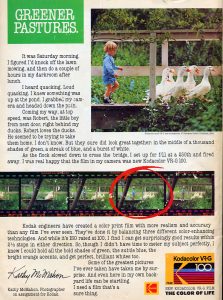
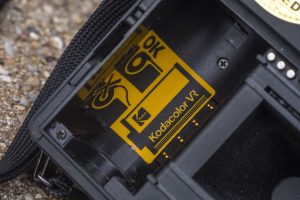
That all changed in 1986 with the release of a new series of Kodak cameras called the VR35 which made it’s debut along with a new type of color Kodak 35mm film, called Kodak VR-G film. The “G” stood for Gold, and would be the same film eventually renamed to Kodak Gold. In total, there were fifteen different models of VR35 cameras released between 1986 and 1987.
When it was time to build these new cameras, things had changed dramatically since Kodak’s last American built 35mm camera, and the financial burden to construct an all new model from the ground up was too much, so Kodak did what many American companies had been doing, which was outsource construction to someone else. I’ve read that Kodak used a couple different companies for different models within the VR35 series, but for the top two models, the K12 and K14 “Medalist”, Kodak used Chinon Industries of Japan.

Both the K12 and K14 looked very similar, and at a quick glance seem to only differ by the inclusion of a date back on the K14. Although the date back was the biggest difference, there were three others, the first was a dual mode flash that could both be forced on for a “fill flash” but also forced off to force the camera to use longer shutter speeds for nighttime photography. The K12 lacked the flash disable feature and only had the fill flash mode. The final two differences were an increase in the camera’s warranty from three to five years, and a change to the look of the hand grip’s body covering.
s all. Close the camera. It does the rest. It moves the film after each shot. After the roll is finished it rewinds the film. And its easy to remove. -Dorothy HopkinsBelow is a television commercial for the “Kodak VR35”. Although the commercial doesn’t mention either K12 or K14 designations, you can tell it is a K12 by the vertical lines on the hand grip’s body covering.
It is clear that Kodak took their re-entry back into the 35mm camera market seriously. While we can look back today and laugh at the camera’s large and brick-like shape, this was less of a concern in 1986 when this model hit the market. Although Kodak was not a major player in the camera business, they were still the world leader in film, so people likely had no problem trusting a new model from a company who hadn’t seriously competed for their camera buying dollars in over a decade and a half.
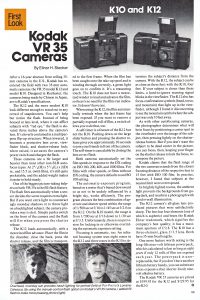
Between the 15 models in the VR35 family, the line-up was reasonably successful. A quick search of “VR35 Camera” on eBay brings back 166 results suggesting a decent number were sold. I can’t say with any certainly how many of the K12 or the K14 were sold, but their higher prices likely meant that they didn’t sell as well as the cheaper models.
To collectors today however, both the K12 and K14 represent a tremendous value if you can find one in good working order. Like all plastic point and shoot electronic cameras from the 1980s, condition is everything. These cameras were not meant to stand the test of multiple decades sitting in someone’s closet, suffering the rigors of time. I doubt anyone working in 1986 for Kodak (or Chinon) put any thought as to what an Internet blogger might be saying 33 years in the future, but here we are, and I am telling you, this is a nice camera and one worthy of adding to your collection.
Nevertheless, with the camera’s excellent lens, good flash, and capable auto focus and auto exposure system, these cameras often sell for very little on the used market, and are competitive alternatives to higher priced models made by Yashica/Kyocera, Contax, Nikon, or Canon.
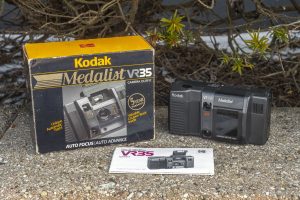
My Thoughts
Lets get one thing out of the way, the Kodak VR35 K14 (I’ll group the K12 in here too even though I don’t have one) is not an attractive camera. One could make the argument that most plastic point and shoot cameras from the 1980s were ugly, but I think that cameras like the Canon MC, Nikon One Touch AF3, and Ricoh FF-90 have their own visual appeal. From a cosmetic standpoint, the Kodak is an oversized plastic brick. It is like what the Argus C3 might have looked like had it been envisioned as a 1980s automatic everything camera.
Yet, if you were to judge this camera entirely by it’s looks and design, you’d be missing out on a pretty incredible camera as Kodak (actually Chinon, the company who built it) did quite a few things right.
Let’s start with the flash. Whether you need a flash or not, the large hinged flash must be opened to use the camera as the flash not only doubles as a lens cap, but is also the power switch for the camera. Swing the flash up and the camera is ready to go, fold it down and it’s ready to be stored. This likely had a positive impact on battery life as it would be very difficult to accidentally store this camera powered on.
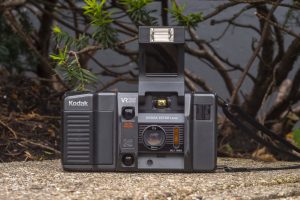
The height of the flash has a benefit in red-eye reduction. The closer a flash is to the center of the lens, the greater the chance that light from the flash will bounce back through the pupil of your subject’s eye and create the dreaded red-eye look that became common with flash photography in small point and shoot cameras. Having the flash about 2 inches above the lens recreates a similar effect you get with an SLR camera with it’s swing up flash, or even that of an auxiliary speed light. That’s not to say you still can’t have red eye, but the effect is reduced.
As for the flash itself, it performs unusually well compared to those on other point and shoot cameras. According to the user manual, it has a maximum reach of 15 feet when using ISO 100 film and up to 30 feet when using ISO 400 film. Comparing that to the previously mentioned Nikon One Touch AF3 and Canon MC, those cameras can only reach up to 18.7 feet and 13.1 feet respectively. Flash recycling time (the length of time after a flash before it is ready again) is quite good too, at only 1.7 seconds.

Both the VR35 K12 and K14 have a fill flash option which forces the flash on in daylight situations where the meter doesn’t think it’s needed, but in the K14 only, there is the ability to force the flash off for slow speed night time photos.
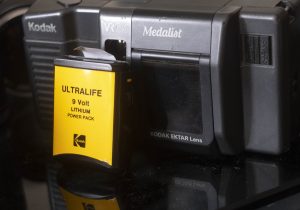
Another unique feature of this camera is something that I don’t think I’ve ever discussed before in any camera review on this site, which is it’s battery. Unlike other point and shoot cameras of the day that relied on AA or AAA alkaline batteries, the Kodak VR35 K12 and K14s used a proprietary 9-volt Lithium battery called the Kodak Ultralife. This battery was unique to this camera, and came standard with a five year warranty from Kodak. It was rated at 100 24-exposure rolls using the flash 2/3rds of the time. Amazingly, the camera that I used for this review came to me with one of these batteries still in it and it had a charge. It quickly died, so I replaced it with a 9v Energizer battery, but it’s pretty impressive that after at least 25 years, it had any power left.

In the event the lithium battery were to die, you could install a standard 9v alkaline battery in it’s place. A sticker on the inside of the battery door gives instructions for how to insert a 9v battery into place, and a wire spring helps hold the battery in place when you close the door. I know of no other camera ever designed that can use both a lithium battery pack or an alkaline replacement. Although the life expectancy of an alkaline battery was far less than the lithium pack, every feature of the camera still worked as normal with one.
As great as the flash and battery are, the single thing that make both the K12 and K14 such gems is the lens. Designed by Kodak and built by Chinon, both cameras feature a 4-element Tessar style 35mm f/2.8 multi-coated all glass “Ektar” lens. Although millions of cameras throughout the 20th century came with Tessar lenses with little fanfare, the inclusion of one in a plastic automatic everything point and shoot camera from 1986 is something to celebrate. Highly regarded cameras like the Yashica/Kyocera T-series cameras came with Tessars too, although their lenses were half a stop slower at f/3.5, yet these are cameras that regularly fetch well over $100 on auction sites today.
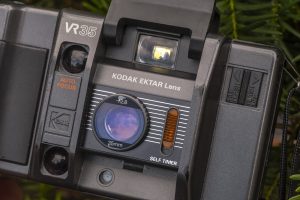
It may not look pretty, but when combined with an advanced infra-red auto focus and fully programmed auto exposure system, the optical systems of both the K12 and K14 are on par of the best that was available at the time. Kodak may have had a “complicated” reputation with quality cameras throughout the 20th century, and perhaps the silk-screened “Medalist” logo was a bit of a stretch, at the very least, the K12 and K14 cameras represented one heck of a good value for customers looking for a top tier point and shoot camera in 1986.

The rest of the camera is pretty typical fare for a 1980s point and shoot 35mm camera. The top plate is a vast sea of grayish-black plastic with the only control the shutter release button. The camera supports the ability to continuously fire the shutter at a speed of 0.5 fps if you hold down the shutter release. The shutter release also supports pre-focus, in which you can half press the shutter release and the camera will detect and hold the focus distance on whatever is in the center of the viewfinder, and allow you to recompose your shot and capture an image without the camera having to refocus again. This is useful when your desired subject is not in the center of your image.
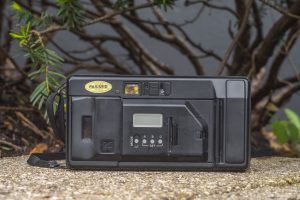
The back of the camera features the most significant (but not only) difference between the K12 and K14 models, which is the inclusion of a date back. Like many cameras of the era, you could optionally imprint the date or the time that the photograph was taken in the corner of each image using the buttons and LCD on the rear film door. The electronics for the date back are powered by a separate CR2025 coin battery located in a small compartment on the film door. The camera will still operate normally with a dead or missing date back battery.
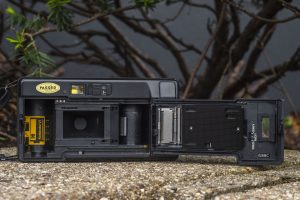
Loading film into the camera is a snap, thanks to the almost completely automatic loading system. The take up spool is a large rubber coated drum that requires you to simply extend the leader of a new roll of film to the yellow line indicator, and close the door. Once the door is closed, flip up the flash and press the shutter release once and the camera will automatically advance the film to the first exposure. Both the K12 and K14 support automatic DX detection, so the camera will automatically detect the film speed of films 100, 200, 400, and 1000 which were the only 4 speeds Kodak’s VR-G film was available in at the time. If you use non-DX encoded film, or an unsupported film speed, the camera will treat it like 100 speed film.
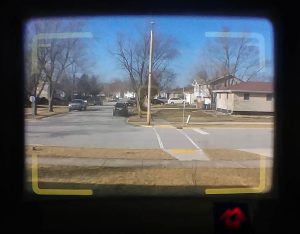
If you’ve ever handled a 1980s auto focus point and shoot camera, the viewfinder will look very familiar to you. A bright reverse Galilean straight through viewfinder with projected frame lines with parallax hash marks, and a central auto focus squared circle are all present. As are a couple red LED status lights along the bottom. For instances where a flash is deemed necessary, a red lightning bolt will flash, as will one of three detected focus zones, one for closeups, one for portraits, and one for landscapes. Although only one of 3 icons will be displayed, the camera’s auto focus system detects as many as eight different focusing zones.
As you can see, this camera is a hodge podge of some really nice features in a strange and large body. The ergonomics aren’t great, but in general use, don’t get in the way too much either. The location of the self-timer on the front of the camera is awkward, as is the two-way flash fill/override switch, but these are the controls you’re likely to use the least. At 425 grams with the Ultralite battery, the camera is heavy compared to other point and shoots, but still lightweight compared to SLRs of the day. I can see why these cameras don’t have the reputation that their feature set suggest they should have. I never thought much of them either until after learning of their merits.
So, now that we’ve talked about the looks and features of the camera, how does it shoot?
My Results
In hindsight, my choice for the first roll of film through the VR35 K14 probably should have been some variant of Kodak Gold since that was the film whose release coincided with this camera, but instead, I went with Fuji 200 which I still have a whole freezer full of. I carried the camera with me as an everyday “snapshot” camera in late summer 2018, which is consistent with how it would have likely been used when it was new. Although the K14 has some “step up” features from lesser VR35s, this was not a pro’s camera, it was marketed towards the average family man, who just so happened to have a few extra dollars in their pocket.
There are many cameras from the 1980s that are highly regarded for the quality of images they can make. The Kodak VR35 K14 is not one of them, but it should be. Looking at the images in the gallery above, I would have believed you if you told me these came from a high end German point and shoot, or even an SLR. With the sole exception of a tiny amount of vignetting in some outdoor photos, the images are nearly perfect. Color accuracy is excellent, contrast is excellent, sharpness is excellent. The camera’s metering and auto focus system worked well, even indoors. The garish green florescent cast of the lights from the train picture are accurately rendered here. I used the fill flash feature a couple of times outdoors and it worked wonderfully. I’m only showing 10 of the 24 images from my first roll, but frankly, I could have shown the whole roll and they would have all looked just as great.
Kodak has made some really great cameras in the past. While they don’t enjoy the legendary reputation of other mid 20th century camera marques like Zeiss, Leitz, or Nikon, many of Kodak’s earlier cameras were quite good. Of the ones that were “quite good”, many of them used names like “Medalist” and “Ektar” so when I first started shooting this camera, I’ll admit to having a bit of cautious excitement as to what the camera could do.
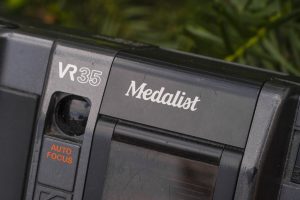
From a usability standpoint, the camera works much like most other automatic mid-80s point and shoots. The camera is a bit on the large side and with questionable ergonomics, but all of that was forgiven when I saw the images.
While I question the decision to label this camera as a “Medalist” with an “Ektar” lens as it shares absolutely nothing in common with the original Kodak Medalist or it’s 5-element Ektar lens. The one here is a 4-element semi wide-angle f/2.8 lens that is likely a Tessar inspired design. If Kodak was looking to tap into their past for a high quality point and shoot camera, perhaps they should have called this the “Signet”.
Nevertheless, this Medalist with an Ektar lens absolutely lives up to the reputation of it’s ancestors in how painlessly it delivers fantastic results and is a camera I highly recommend if you have an opportunity to pick one up.
Related Posts You Might Enjoy
External Links
http://camera-wiki.org/wiki/Kodak_VR35
https://www.35mmc.com/23/02/2021/chinon-auto-2001-kodak-vr35-k14-review
https://www.chicagotribune.com/news/ct-xpm-1986-08-08-8602270456-story.html

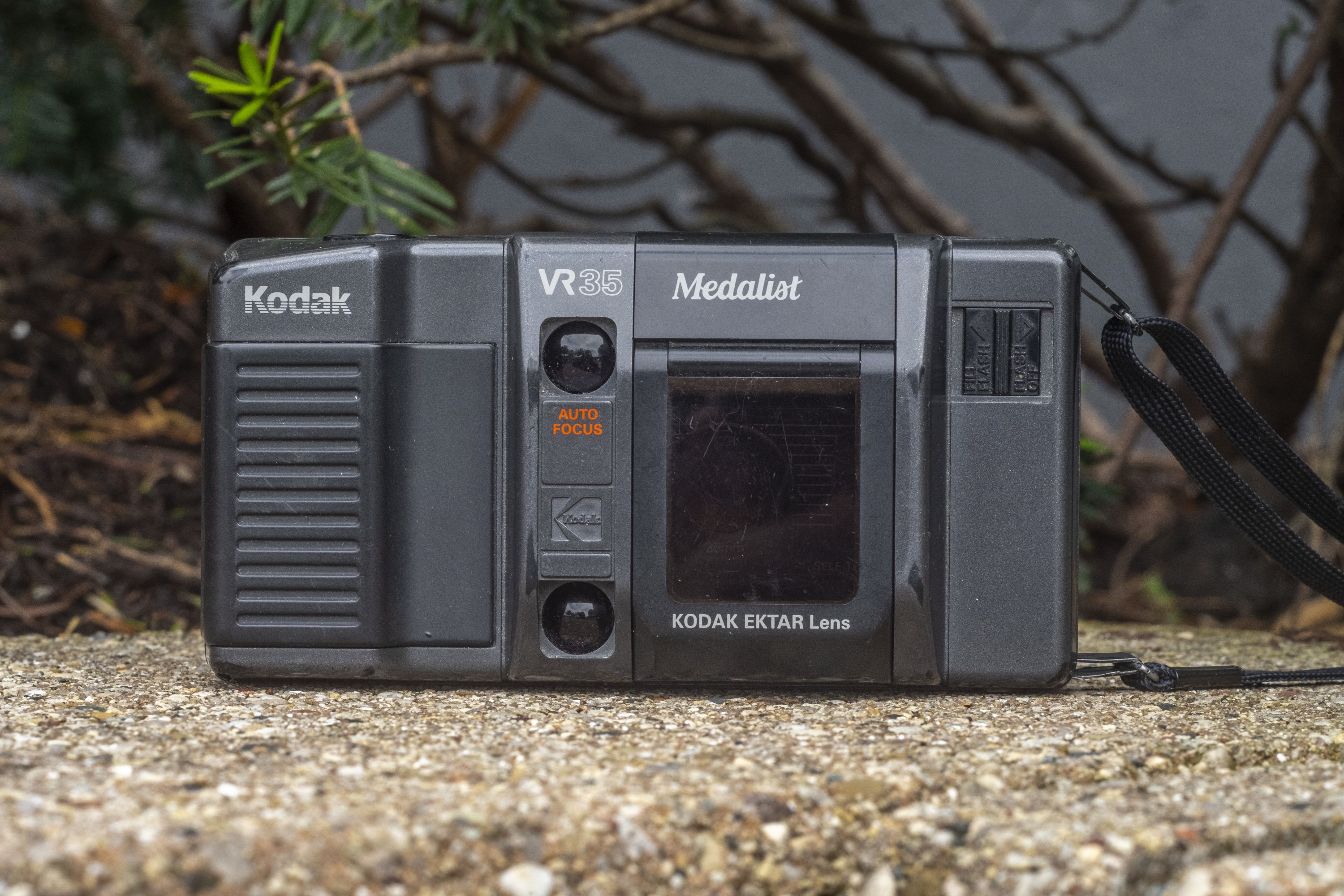
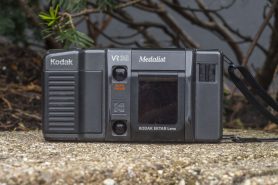











Thanks for an interesting review, Mike. BTW, the Pentax K30 DSLR is the “other” camera that uses two entirely different batteries: Your choice of (4) AAs, or a single rectangular Li-Ion cell that fits diagonally into the compartment.
Thanks for the additional info Roger. I have no experience with the D30, but it being digital, that would explain it! 🙂 I also know that some 80s cameras like the Nikon F301/F501/N2000/N2020 normally used AAA batteries, but had an optional AA battery older that you could use instead, and of course theres many that support external battery supplies too.
KODAK, JAPAN’S CHINON PLAN A 35-MM. CAMERA
By ERIC N. BERG
Published: March 6, 1985
http://www.nytimes.com/1985/03/06/business/kodak-japan-s-chinon-plan-a-35-mm-camera.html
The Eastman Kodak Company, which has reportedly been disappointed by recent sales of its disk camera and instant-photography camera, yesterday announced a renewed effort to capture part of the booming market for 35-millimeter cameras. It said it would produce such a camera with Chinon Industries of Japan, a technology partner.
In an announcement from its Rochester headquarters, Kodak said that employees from both companies would be part of a team designing a 35-millimeter camera. Except for a lens part to be built in Rochester, almost all manufacturing will be in Japan at first, Kodak said. But it added that production could eventually be also done in Rochester.
The company did not say where it would sell the camera, which will bear Kodak’s name. Kodak currently does not sell a 35-millimeter camera in the United States.
Analysts had mixed reactions. A few said that by taking this step Kodak was in effect disclosing the extent of its problems with its current camera line. But they praised the company for showing a willingness to produce more salable products.
‘Correcting Course’
”The cartridge business has not done well,” said Brian R. Fernandez, a senior researcher at the Wall Street firm of Nomura Securities. ”The instant business has not done well. Kodak has never been far from the mainstream, and they are now correcting course.”
Kodak rejected this interpretation. ”We’re not saddened by the disk or the instant camera,” Charles Smith, a spokesman, said. Asked if Kodak might drop the lines, he said, ”There are no plans that I’m aware of to do that.”
Nevertheless, Kodak concedes that after an extremely strong start, sales of both cameras have tailed off considerably. Industrywide unit sales of instant cameras, for instance, have declined from a peak of around eight million in 1982 to less than three million last year, according to industry statistics.
The 35-millimeter market, on the other hand, is said to be extremely robust. Advances in electronics have made these cameras lighter, less expensive and increasingly automatic. The result has been a growth in annual sales exceeding 20 percent. Last year alone, according to Mr. Fernandez, worldwide sales of 35-millimeter units exceeded $500 million.
Almost all that growth has been for so-called range-finder cameras, in which the camera’s viewer is separate from its lens. These cameras are generally easier to use than single- lens reflex cameras, in which the photographer looks through the lens and typically must make adjustments for shutter speed and aperture size. Kodak would not say which type of model it would produce, but a simple range-finder version seemed virtually certain, analysts said.
But to succeed, said Peter G. Wolff, a vice president in Tokyo for Bache Securities Japan Ltd., Kodak will have to apply its marketing strength because there are nearly 100 competitors in the range-finder market.
Wow! This is an awesome find, Cheyenne! Thanks for sharing!
Mike, are you aware of two lens attachments to the K14?
I know I came across somewhere the existence of them, but no, I’ve never seen one. I assume they just slip over the lens and have some type of extra window that covers the viewfinder window to show either a tele or wide view like I’ve seen for other point and shoot cameras.
Hi Mike, thanks for the awesome review! Do you know if there’s a way, after flipping the cover up, to pop off the front glass so I can blow the dust off of it?
Hi Bryan, thanks for the compliment. Although I never did try to take mine apart, taking a quick look at it, I don’t believe that cover was designed to be easily taken apart. Kodak made these things in a way so as to discourage tinkerers. I’m sure it’s possible, but you’ll have to figure out how to completely tear apart the camera. As long as it’s just tiny pieces of dust, it wont have any impact on your images. Haze or fungus will, but dust particles won’t. I would just try to shoot the camera and see what happens.
Thank you for the info! I just scored a K12 and can’t wait to use it!
Awesome write up, Mike.
I just found a K12 in near-mint condition at a yard sale today and bought it for a fiver. The original lithium battery is in it and amazingly still works. I’m excited to see what I get out of it after reading your review!
Nice find! The K12 and K14 have the same exact lens, so I would expect you’ll get some really fantastic shots with it! Please let me know how they turn out!
Thank you for this, it’s very helpful. I got a K14 in 1987 and used it for years. It’s been stored away for the last couple of decades and now my daughter is very keen on using a “film camera”…much like record players they’re a real novelty for her generation. I couldn’t find a lithium battery for purchase anywhere except in the US (they won’t ship to Australia), so I will try the 9V Alkaline substitute…wish me luck!
Angie, assuming the camera has no other problems, a 9v battery will definitely work as it was specifically designed to work with them in the event the original Lithium battery pack was not available. A 9v battery wont last as long as the original battery pack, but it should be good for at least a few rolls for your daughter! Hopefully everything works well and she has a positive experience with it!
Interesting article! I’ve seen some Kodak VR35 cameras but they were always the simpler fixed focus versions. Kodak had a habit of making proprietary things just because they could… new film formats that weren’t needed like 620 and 616, new batteries that weren’t needed like the K battery for 110 cameras, etc.
Back in the 80s and early 90s lithium batteries were still new and exciting so maybe people thought a 5 year life was all you would need for a camera or piece of electronics. Fuji made a camera with a lithium battery that was hidden behind screws so consumers were told to take it to a camera shop to replace the battery. Other electronics had clock batteries or memory backup batteries soldered to the circuit board.
I use a Chinon CP-7m 35mm SLR right now. It’s an ugly, black plastic camera from 1986 and it can use 4 AA batteries or one 2CR5 battery. The 2CR5 batteries are expensive but not as bad online. They work for much longer, are lighter than AA batteries, and work in cold weather much better too.
Lithium batteries certainly offer a benefit over AA and AAA batteries in terms of life, but with so many old battery styles no longer existing, cameras that can use AA and AAA are more ideal these days.
And I know exactly which Fuji camera you’re talking about with the non-user-replaceable internal battery. Its the TW-3 and I have one, and I’ve even replaced the battery! Still haven’t shot it though, but whenever I do, expect to see a review of it here!
This camera(K14) took the best photos from all the cameras I used. My kids dropped it and broke the back battery body and a small piece above lens and counter. Still have the pieces lol. Would definetly buy another one.
I’ve never been able to find out which Japanese company built these cameras for Kodak, but whoever did, did an excellent job! The lenses on these are as good as any out there at the time!
Hi Mike: Thanks for your excellent article, which I found after searching for information on the K14. My wife and I were cleaning out a cabinet to make room for my moving our offices home. We came upon my K14 in pristine condition, bringing back all those memories associated with having purchased a new camera when our daughters we’re just toddlers.
There was a roll of film in mine. I’ll soon find a place to send for developing. It’s a Kodak gold GA 24 •100/21*
What film do you recommend? I know you mentioned you had a bunch of Fuji, but you used that because you already had it. I’ll have to buy some new film and I’m wondering what you suggest.
Also, have you a suggestion for a mail in place to have it developed? Thanks very much.
Richard Michaelson Maple Shade NJ
Thanks for the compliment Richard, I am happy you enjoyed the article.
For film recommendation, if you think you’ll shoot more than one roll of film, my favorite color film right now is Kodak ProImage 100. It only comes in 5-packs though, but for less than $30 for a pack, it’s a great value and produces more natural colors than cheaper color films like Fuji and Kodak 200.
https://www.bhphotovideo.com/c/product/1476367-REG/kodak_6034466_kodak_proimage_100_135_36.html
For development, there’s a ton of good options, but my favorite is Dwayne’s Photo in Parsons, KS. They are one of the more reliable developers out there and they consistently do a good job for a reasonable price.
https://www.dwaynesphoto.com/
If you do end up getting back into film photography and see this as something you’ll want to keep doing, I strongly recommend investing in developing film yourself. It is a lot easier than you think. I do all my own color and black and white developing in my laundry room. You don’t need a dark room! Of course the up front cost is a bit high to buy everything you need, plus a scanner, but once you have it, developing a roll of film has a net cost of less than a dollar a roll!